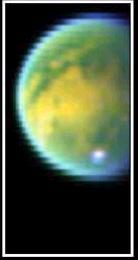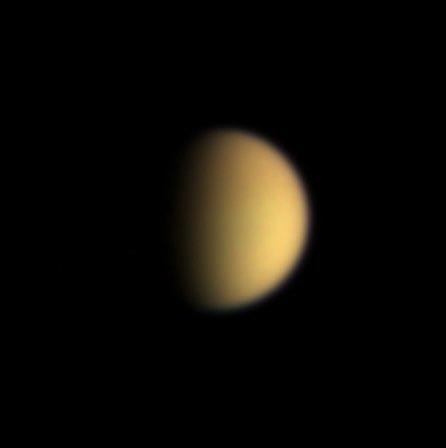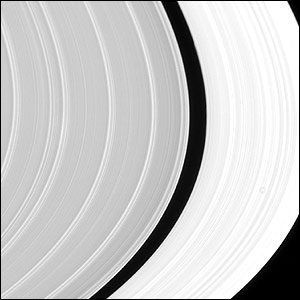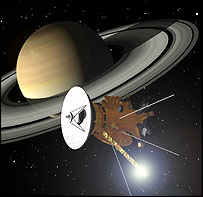The game of cosmic billiards brought Cassini a total of 36 hours after arriving in the Saturn system and crossing the rings, into relatively close proximity to the interesting moon Titan

After peeling back the haze covering Titian, these images from Cassini combine visible and infrared mapping to reveal exotic surfaces covered in a variety of materials in the Southern Hemisphere. The rounded pattern may be a crater in the north.
With the help of the use of colors in the near infrared, 10 times the red color visible to the human eye - the surface is exposed with unusual clarity. The color image is a combination of unnatural colors of three previous images. The yellow areas are the richest in hydrocarbons, while the green are the more glacial areas. The methane can appear white, as well as the lighter parts of all three colors.
From preliminary data transmitted by Cassini of Saturn's moon, Titan, mainly methane clouds are visible as well as a huge crater on the surface of the moon itself. The spacecraft used its instruments to penetrate a thick layer of fog in Titan's atmosphere, and the data shows that there was some geological activity on the moon's surface. The most obvious thing picked up is a cloud-like cumulus near Titan's south pole, which scientists estimated to be about 450 kilometers across and about 15 kilometers high.
Cassini data indicates that the clouds are most likely made of hydrocarbon, and are related to the ground conditions themselves. Doctor Kevin Baynes, a member of the team studying the Cassini data: "There are wind movements here that raise the methane density in the air to a point where a lot of clouds are concentrated." Titan's dense atmosphere. Although some of the data is unclear and difficult to decipher, we are happy to report that through a combination of means, we were indeed able to see the surface of Titan.
Also, we are looking to the future, and I believe we will soon have better data," said another team member, Dr. Dennis Matheson. Cassini will reach a distance of about 1,200 kilometers above Titan's surface, and then the data will be clearer. For now, scientists speculate that some areas on the planet's surface are covered in water ice mixed with hydrocarbon compounds. The darker areas are most likely covered by purer water ice.
Remember, these maneuvers actually begin a 4-year journey, during which the spacecraft will circle Saturn 76 times and approach some of its 31 moons, including the giant Titan.
Cassini made the first of 40 flybys of Titan * Photos - coming soon
3/7/04

The most updated photo of Titan from the NASA website - from June 10, 2004, from a distance of 13.1 million kilometers. We are still waiting for the close-up shots.
The Cassini-Huygens spacecraft took advantage of the first opportunity to fly close to Saturn's largest moon, Titan. The spacecraft was able to locate large straight terrain features on Titan's surface that are hidden from Earth observers due to Titan's thick atmosphere.

The imaging experts say that these may be tectonic structures - areas of fractures shaped by movement.
Cassini passed 350 kilometers from Saturn's moon, which is much larger than our moon, which happens to be roughly its distance from us, so in cosmic terms it is a good proximity.
Not only is Titan an important science target of the Cassini mission, it can help in another way as well, its size providing enough gravity to help it make changes to the spacecraft's orbital path. This means that Cassini will be able to be directed to different parts of the Saturn system without using too much fuel.

Cassini will also release Huygens from it, which will land on Titan in mid-January 2005. All in all, the spacecraft arrived at Saturn last Thursday and had time to cross the rings and photograph them from both sides. Some of the images include density waves in the rings, reminiscent of bands of different widths. In other pictures the rings appear to have jagged edges.
